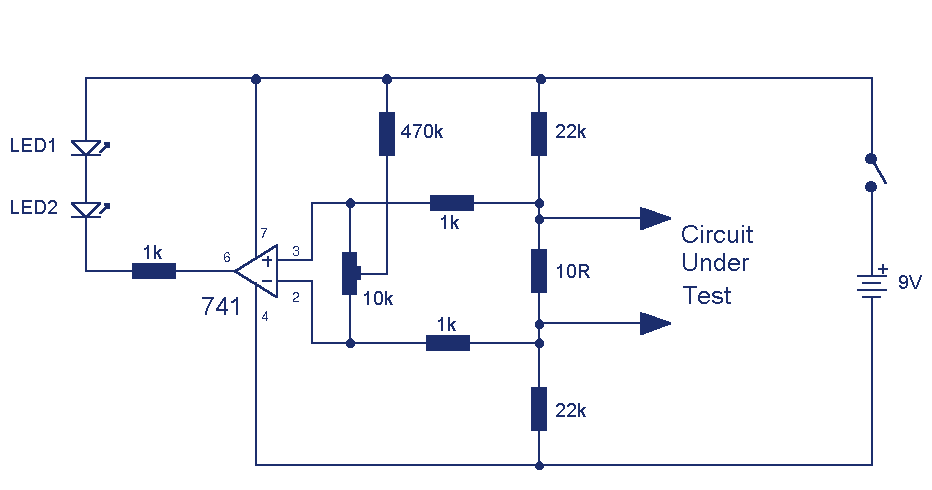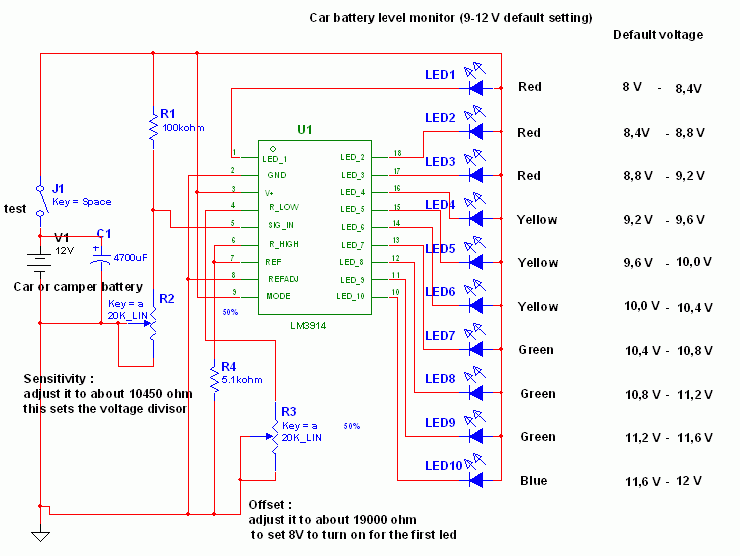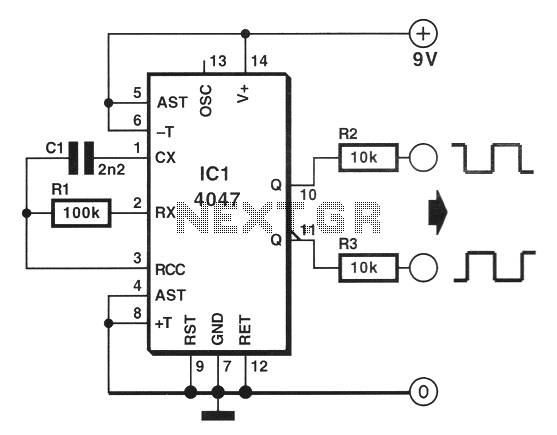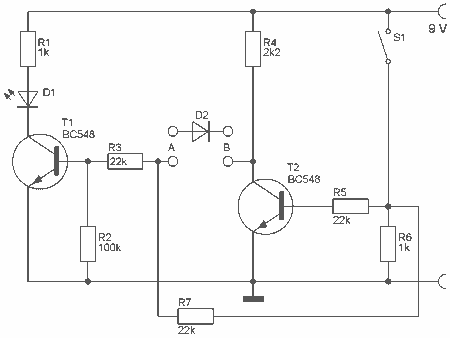
Connection Tester

A low resistance (0.25 - 4 ohm) continuity tester for checking soldered joints and connections. This simple circuit uses a 741 op-amp in differential mode as a continuity tester. The voltage difference between the non-inverting and inverting inputs is amplified by the full open loop gain of the op-amp. Ignore the 470k and the 10k control for the moment, and look at the input of the op-amp. If the resistors were perfectly matched, then the voltage difference would be zero and output zero. However, the use of the 470k and 10k control allows a small potential difference to be applied across the op-amp inputs and upset the balance of the circuit. This is amplified causing the op-amp output to swing to full supply voltage and light the LED.
The continuity tester circuit described utilizes a 741 operational amplifier (op-amp) configured in a differential mode to detect low resistances typically found in soldered joints and connections. The operational amplifier's differential input allows for the measurement of small voltage differences, which are indicative of continuity in the circuit being tested.
In the absence of any applied resistance, the circuit is designed such that the voltage difference between the non-inverting (+) and inverting (-) inputs of the op-amp is ideally zero. Under these conditions, the output of the op-amp remains at zero volts. However, the introduction of a 470kΩ resistor and a 10kΩ potentiometer serves to create a small imbalance in the input voltages. This imbalance is crucial as it allows for the detection of low resistance values.
When a low resistance (between 0.25Ω and 4Ω) is present across the test leads, it generates a slight voltage difference that is amplified by the op-amp's open-loop gain. The output of the op-amp will then swing towards the supply voltage, which can be used to drive an indicator, such as an LED. The LED acts as a visual indicator of continuity, lighting up when a connection is established.
The selection of the 470kΩ and 10kΩ components is essential for adjusting the sensitivity of the circuit. The potentiometer can be calibrated to fine-tune the threshold at which the LED will illuminate, allowing for flexibility in testing various types of connections and solder joints. This simple yet effective circuit design provides an efficient means of verifying electrical connections, ensuring reliable performance in electronic assemblies.A low resistance ( 0.25 - 4 ohm) continuity tester for checking soldered joints and connections. This simple circuit uses a 741 op-amp in differential mode as a continuity tester. The voltage difference between the non-inverting and inverting inputs is amplified by the full open loop gain of the op-amp. Ignore the 470k and the 10k control for the moment, and look at the input of the op-amp. If the resistors were perfectly matched, then the voltage difference would be zero and output zero. However the use of the 470k and 10k control allows a small potential difference to be applied across the op-amp inputs and upset the balance of the circuit. This is amplified causing the op-amp output to swing to full supply voltage and light the LED' 🔗 External reference
The continuity tester circuit described utilizes a 741 operational amplifier (op-amp) configured in a differential mode to detect low resistances typically found in soldered joints and connections. The operational amplifier's differential input allows for the measurement of small voltage differences, which are indicative of continuity in the circuit being tested.
In the absence of any applied resistance, the circuit is designed such that the voltage difference between the non-inverting (+) and inverting (-) inputs of the op-amp is ideally zero. Under these conditions, the output of the op-amp remains at zero volts. However, the introduction of a 470kΩ resistor and a 10kΩ potentiometer serves to create a small imbalance in the input voltages. This imbalance is crucial as it allows for the detection of low resistance values.
When a low resistance (between 0.25Ω and 4Ω) is present across the test leads, it generates a slight voltage difference that is amplified by the op-amp's open-loop gain. The output of the op-amp will then swing towards the supply voltage, which can be used to drive an indicator, such as an LED. The LED acts as a visual indicator of continuity, lighting up when a connection is established.
The selection of the 470kΩ and 10kΩ components is essential for adjusting the sensitivity of the circuit. The potentiometer can be calibrated to fine-tune the threshold at which the LED will illuminate, allowing for flexibility in testing various types of connections and solder joints. This simple yet effective circuit design provides an efficient means of verifying electrical connections, ensuring reliable performance in electronic assemblies.A low resistance ( 0.25 - 4 ohm) continuity tester for checking soldered joints and connections. This simple circuit uses a 741 op-amp in differential mode as a continuity tester. The voltage difference between the non-inverting and inverting inputs is amplified by the full open loop gain of the op-amp. Ignore the 470k and the 10k control for the moment, and look at the input of the op-amp. If the resistors were perfectly matched, then the voltage difference would be zero and output zero. However the use of the 470k and 10k control allows a small potential difference to be applied across the op-amp inputs and upset the balance of the circuit. This is amplified causing the op-amp output to swing to full supply voltage and light the LED' 🔗 External reference
Warning: include(partials/cookie-banner.php): Failed to open stream: Permission denied in /var/www/html/nextgr/view-circuit.php on line 713
Warning: include(): Failed opening 'partials/cookie-banner.php' for inclusion (include_path='.:/usr/share/php') in /var/www/html/nextgr/view-circuit.php on line 713





